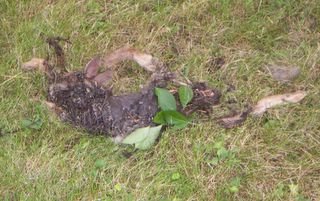C.S.I.: Waterloo
Important note: this is a pretty gross post--please don't read it while eating. Don't worry--I am sparing you guys the photos I took.

[Image taken from the Australian Museum's web page.]
As I was heading out the door of my apartment a few days ago, I got a good whiff of something that smelled pretty rank. I'm used to random bad smells around here--you can tell the days that wind is coming from the west by the smell of pig farms. My first reaction was, "Wow... it smells like Chinatown on trash day!" After the smell didn't go away, I realized that there was probably some dead animal in the bushes.
As a side note, the smell of putrescene (the chemical emitted by decaying flesh) is a really distinct and powerfully offensive odor. I think Beemer once pointed out that evolution has done a really good job of making the association of putrescene -> "Don't eat that!" I managed not to hurl while doing my search-by-smell.
I eventually found the carcass--it was a rabbit; I extracted it from the bushes with long wooden sticks. The body had reached the "black putrefaction" stage: portions were skeletonized, while other portions were mostly intact; there was heavy maggot activity. I got it into a plastic sack; it is now in a bunny body bag next to the house.
This experience got me curious enough that I cracked open M. Lee Goff's A Fly for the Prosecution: How Insect Evidence Helps Solve Crimes (NY Times review here). It's odd that I recently mentioned this book in my pillbug posting. The author divided decomposition into several stages: Fresh, Bloated, Decay, Post-Decay, and Skeletal.
I consider the Decay Stage to begin when the combined activities of the maggot masses feeding externally and the anaerobic bacteria internally finally break the skin of the corpse, allowing the gasses to escape and the corpse to deflate. Large feeding masses of maggots are the predominant feature of the early to middle periods of this stage. The corpse is still moist then, and there are large amounts of decompositional fluids present on the surface of the soil and within the earth under the corpse. A distinct odor is associate with this stage of decomposition, and processing the corpse is not a pleasant experience. I have noted a strong correlation between the onset of the Decay Stage and a rise in absences and sick days among my graduate students.
The smell is reduced but still there, likely from the fluids left in the soil. The problem is I keep on thinking I'm catching a whiff of it, even inside. Yugh. At least trash day is on Tuesday, and I'm leaving for three weeks soon.
[Edit: snowninja7 on LJ said: "Pictures! Give us pictures!!!" So, here's the shot.] (White space provided to scroll down, to protect the squeamish.)

Yeah, the little white specks are maggots, indeed. The limbs are pretty non-decomposed--they probably dessicated early. They were only barely being held on to the body with connective tissue.


0 Comments:
Post a Comment
<< Home